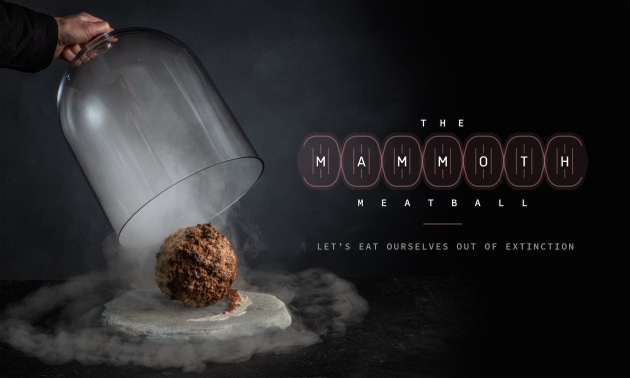Australian cultivated meat company Vow has created the first meat from an extinct animal’s DNA, revealing the Mammoth Meatball at the Nemo Science Museum in the Netherlands overnight.
The meatball is, as it is called, made from the cells of the very extinct Woolly Mammoth, a pachyderm not seen wandering the earth in 5000 years.

The concept was initiated by an international team of experts and scientists and produced by Vow, a start-up that earlier this year applied to FSANZ for its cultivated quail product to be classifed as safe for human consumption.
The experiment was led by the chief creative officer for global agency Wunderman Thompson, Bas Korsten.
Korsten has been described as a ‘creative disrupter’, having initiated The Next Rembrandt project in 2016, a 3D printed painting made using deep learning algorithms and facial recognition from the data of Rembrandt’s body of work.

Vow co-founder and director Tim Noakesmith said Vow’s mission was to feed billions of humans and change people’s concept of what meat is and what it can be.
“We do that by growing meat from the cells of animals instead of the animals themselves. We call it cultured meat.
“Cultured meat significantly reduces the climate change impacts that are normally associated with regular meat production,” Noakesmith said.
Vow’s chief scientific officer James Ryall said the goal behind bringing an extinct protein back to life and creating the mammoth meatball was to start a discussion around food and what the decision to eat meat really means for the world.
“We first identified a mammoth gene called myoglobin that gives the meaty taste we expect in red meat.

mammoth meat was grown from cells inserted
with real mammoth DNA and completed with
small parts of African elephant DNA, the
mammoth's closest living relative. (Source: Vow)
“We then used publicly available data to identify the DNA sequence in mammoth and we filled in any gaps in the DNA sequence of this mammoth myoglobin gene by using the genome of the African elephant, the mammoth’s closest living relative.
“We inserted the mammoth myoglobin gene into our cells using a very low current and high voltage charge. These cells continue to grow and multiply, just as would have occurred in a mammoth thousands and thousands of years ago.
“The amazing thing about this is that not a single animal needed to die to produce the mammoth meatball,” Ryall said.
University of New South Wales professor of molecular biology, Merlin Crossley, said, “If you can do something efficiently in the laboratory in a controlled environment, and you've got a technological solution that works, we should use that.
“I never thought I’d be eating a meatball made of mammoths, but I think it captures how science tries to do the impossible.”
Noakesmith said we needed to radically change how we produce food, and “start eating for tomorrow”.
“The biggest drivers of climate change are intensified animal agriculture. The technology is moving faster than regulatory pathways can keep up,” he said.
Ryall added, “Cultured meat is going to need the support of political systems to generate enough momentum and money to support this brand new technology.”
Noakesmith said, “We need to think differently about our future. We need to get smarter when we think about food and manufacturing at scale. We need to think holistically, and we need products that are better for the planet and sustainable for the future.
“I love the moment when people try it there’s total magic there you see this wide-eyed surprise when they put it in their mouth for the first time and that it’s super delicious.”
Recent cultivated meat news:
Vow applies to FSANZ for cultured quail approval
APAC Cellular Agriculture announces MOU
“Watershed moment for cultured meat”
Vow opens largest cultured meat facility in Southern Hemisphere
Food & Drink Podcast with Tim Noakesmith









![WorldStar 2026 winners announced [UPDATED]](http://yaffa-cdn.s3.amazonaws.com/yaffadsp/images/dspArticle/featureImage/wpo.jpeg)

